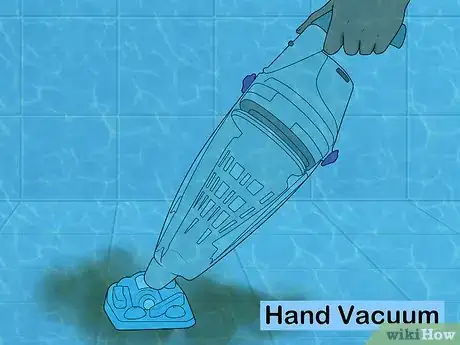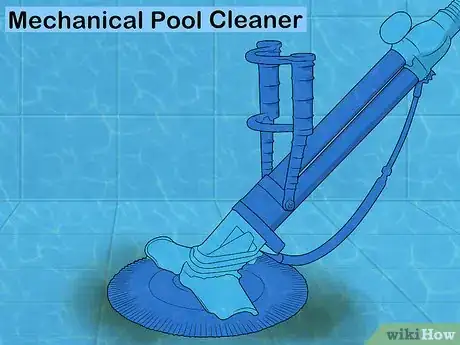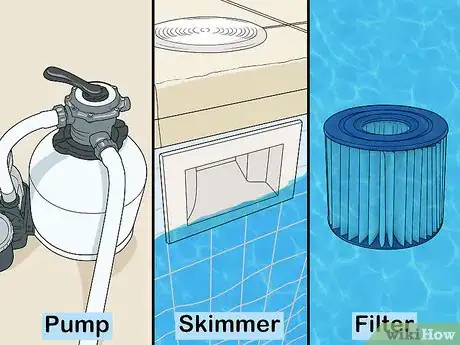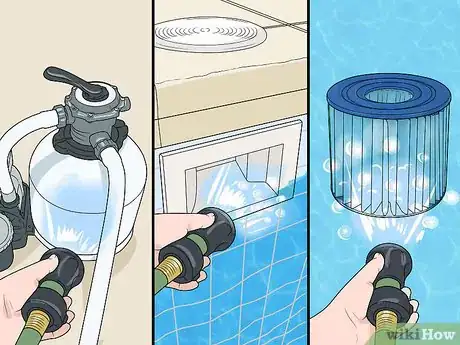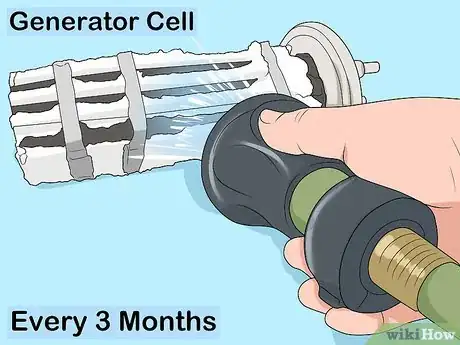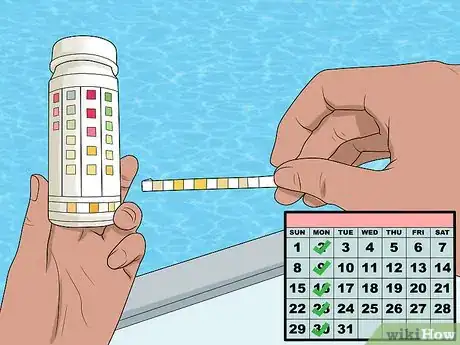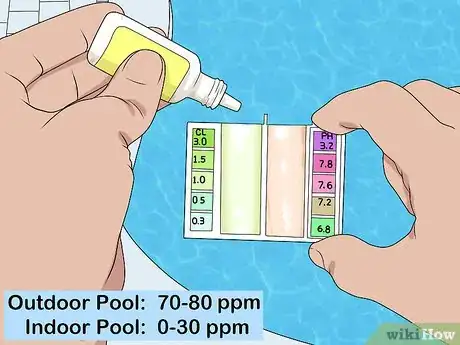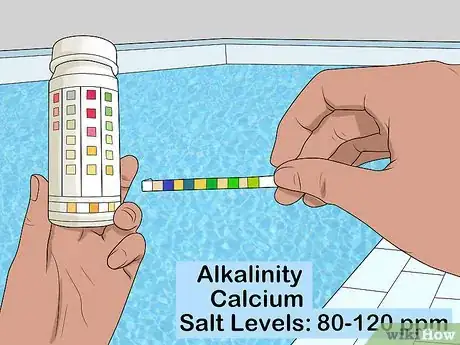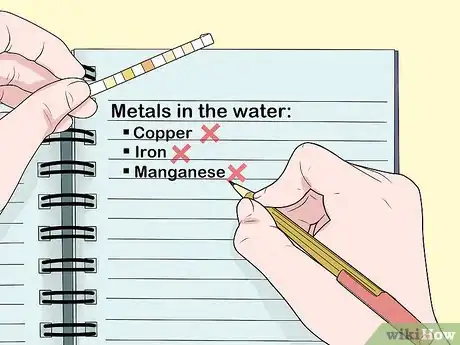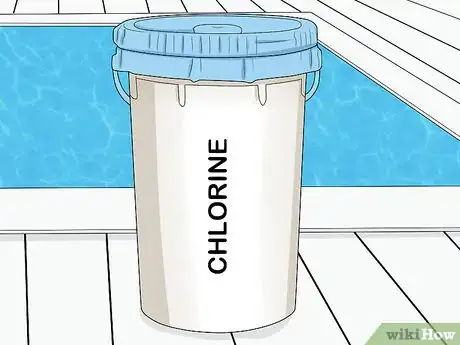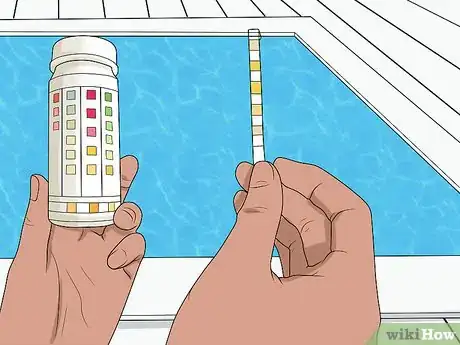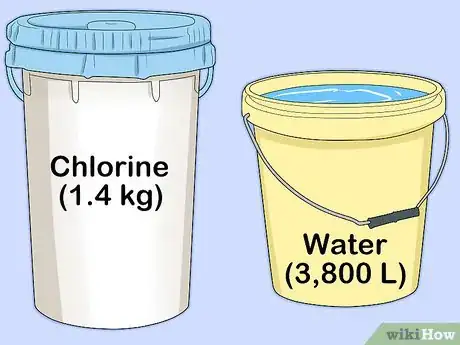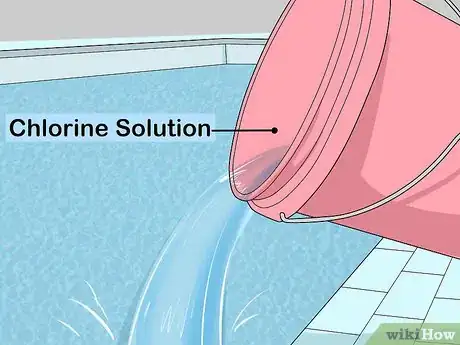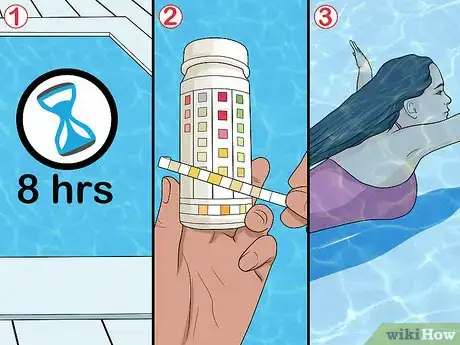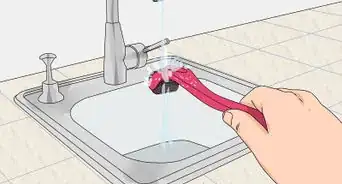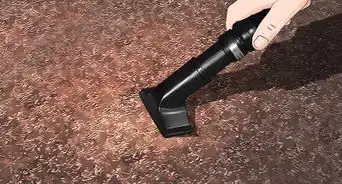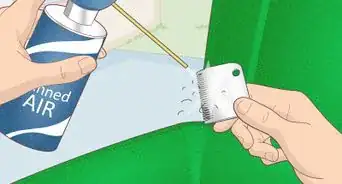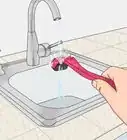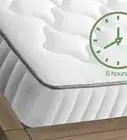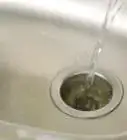This article was co-authored by Rob Litman. Rob Litman is a Landscaper, General Contractor, and the CEO of Vitoli Inc., a landscaping, hardscaping, ecoscaping, and swimming pool design company in Los Angeles, California. With over 20 years of experience in construction, Rob specializes in energy-efficient and drought-tolerant landscaping. He holds General Building Contractor (Class B) and Registered Pool/Spa Contractor Licenses. In 2007, Rob won House of the Year in Gardena, California.
This article has been viewed 46,538 times.
Salt water pools are popular options for homeowners who want a pool in their yard, as they are easier to clean and maintain than chlorine pools. Salt water is also less harsh on skin and hair than traditional chlorinated water.[1] To maintain your salt water pool, you should keep the pool clean, with no debris or dirt. You should also test the salt water to ensure the chlorine, pH, and alkalinity levels are correct in the pool. If you plan to have a lot of people in the pool, you should shock the water so you can all enjoy a clean salt water pool.
Steps
Keeping the Pool Clean
-
1Remove surface dirt and debris with a hand vacuum twice a week. Get a hand vacuum for the pool at your local pool supply store or online. The vacuum attaches to your skimmer box to create suction. You then push the vacuum around the surface of the pool with a pole to suck up dirt and debris.[2]
- A good hand vacuum of the pool will take 1 to 1.5 hours. Get in the habit of cleaning the pool at least 2 times a week, especially if your pool is outdoors and uncovered.
-
2Get a mechanical pool cleaner. You can also buy a mechanical pool cleaner that works on its own to suck up debris and dirt.[3] Look for a suction pool cleaner at your local pool supply store or online. Run the mechanical pool cleaner at least twice a week to keep the pool clean.[4]
- You can also invest in a pressure cleaner or a robot cleaner for the pool, though they will be more expensive.
Advertisement -
3Run the pump, skimmer, and filter in the pool at all times. Your salt water pool should have a pump, skimmer, and filter in it to help keep it clean. Make sure you run these components in the pool at all times to help suck up dirt and debris.[5]
-
4Clean the pump, filter, and skimmer once a week with water. Check the pump, filter, and skimmer once a week to ensure they are not blocked or clogged by debris. Use a hose to blast away any dirt or debris. You can also put the pool components under running water to clean them.[6]
- Clean the pump, filter, and skimmer after a big storm or a large party in the pool, as there will likely be more debris in the pool that can clog these components.
-
5Clean the generator cell every 3 months. The salt in the pool water can build up in the generator cell, causing scaling or crystallizing. Get in the habit of cleaning the generator cell in the pool so it is not clogged and can work properly. Use a high pressure hose to blast off the build up on the cell.[7]
- You can also scrape off salt build up with a wooden or plastic tool.
- If the build up is really stubborn and hard to get off, you can soak the cell in 4 parts water and 1 part muriatic acid. Allow the cell to soak for a few minutes and then rinse it off with water.
Testing the Salt Water
-
1Use a test kit to check the free chlorine and pH levels weekly. Get a quality pool test kit at your local pool supply store or online. The kit may use test strips or a drop test. Check that the free chlorine levels are 1-3 parts per million (ppm). Make sure the pH levels are at 7.2-7.8. This will ensure the pool stays clean and functions well.
- If you need to lower the pH levels in the pool, you can add muriatic acid to the water. To raise the pH levels, add sodium bicarbonate.
- Consult your owner's manual or speak to a professional salt pool cleaner if you need guidance.
-
2Check the stabilizer levels weekly. The stabilizer levels help to prevent the chlorine in your pool from being lost due to UV rays from the sun. Use a test kit to check the stabilizer levels. If you have an outdoor pool, make sure the stabilizer levels are at 70-80 ppm. If you have an indoor pool, you should have stabilizer levels at 0-30 ppm.
- You can lower the stabilizer levels by draining the pool and adding fresh water to dilute the pool water.
- You can raise the stabilizer levels by adding cyanuric acid to the pool water, based on the manufacturer's instructions.
-
3Check the alkalinity, calcium, and salt levels once a month with a test kit. The alkalinity level helps to keep the pH level stable. It should be between 80-120 ppm. You can bump up the alkalinity level by adding baking soda to the water and reduce it by adding muriatic acid.[8]
- The calcium in the water helps to prevent the water from becoming corrosive and cloudy. It should be at 200-400 ppm. You can add calcium to the pool to bump up the calcium level and reduce the amount you add to bring the calcium level down.
- The salt level should be in the range specified by the manufacturer of the pool. This is usually around 2700-4500 ppm. You can add more salt to the water to bump up the salt level to where it should be. Always make sure the cell in your pool is working so the salt can circulate properly.
-
4Check that there are no metals in the water. Make sure metals like copper, iron, and manganese are not present in the water by using a test kit. Check for metals when you add fresh water or at the start of the pool season. These metals can lead to corrosion and other issues in the pool if they are present.
Shocking the Pool
-
1Get chlorine to shock the pool. Look for chlorine solutions designed to shock your pool at your local pool supply store or online. Make sure it is safe for use on all pool types, including salt water pools.
-
2Test the levels in the pool. Make sure the chlorine and pH levels are correct in the pool. Check that the calcium, alkalinity, salt, and stabilizer levels are correct as well. This will ensure shocking the pool will not cause any staining or damage.[9]
- Shocking the pool with chlorine is a good way to prevent the water from becoming cloudy and polluted if you are having a lot of people in the pool. It's also a good way to give your pool a deep clean once a year.
-
3Determine the right amount of chlorine. For a standard size salt water pool, you may use 3 pounds (1.4 kg) of chlorine per 1,000 gallons (3,800 L) of water. Check the manufacturer's instructions if your pool is smaller or larger than the standard size.
-
4Add the chlorine a little at a time. Make sure the filter system is working and the pH is between 7.2-7.4. Add the chlorine a small amount at a time around the edges of the pool. Let the chlorine dissolve into the pool water.
-
5Wait 8 hours and test the chlorine levels before using the pool. Use a test kit to check the chlorine levels in the pool. Make sure the chlorine levels have dropped and the water is safe to swim in before you use the pool.
Expert Q&A
Did you know you can get expert answers for this article?
Unlock expert answers by supporting wikiHow
-
QuestionHow can I keep my pool from looking dull?
 Rob LitmanRob Litman is a Landscaper, General Contractor, and the CEO of Vitoli Inc., a landscaping, hardscaping, ecoscaping, and swimming pool design company in Los Angeles, California. With over 20 years of experience in construction, Rob specializes in energy-efficient and drought-tolerant landscaping. He holds General Building Contractor (Class B) and Registered Pool/Spa Contractor Licenses. In 2007, Rob won House of the Year in Gardena, California.
Rob LitmanRob Litman is a Landscaper, General Contractor, and the CEO of Vitoli Inc., a landscaping, hardscaping, ecoscaping, and swimming pool design company in Los Angeles, California. With over 20 years of experience in construction, Rob specializes in energy-efficient and drought-tolerant landscaping. He holds General Building Contractor (Class B) and Registered Pool/Spa Contractor Licenses. In 2007, Rob won House of the Year in Gardena, California.
Licensed Landscaper & General Contractor
-
QuestionAfter filling my pool, the filter was not hooked up and now it is green. I put prime and 40 lbs of salt and have been running filter for 3 days and checking and cleaning skimmer basket and sleeve under.
 Community Answer1. Scrub off any loose algae on the walls of the pool. 2. Vacuum up any algae on the bottom of the pool. 3. Shock pool. 4. Test chemical levels in the pool. 5. Adjust the chemical levels in the pool.
Community Answer1. Scrub off any loose algae on the walls of the pool. 2. Vacuum up any algae on the bottom of the pool. 3. Shock pool. 4. Test chemical levels in the pool. 5. Adjust the chemical levels in the pool.
References
- ↑ http://www.ocala.com/news/20130621/easier-and-cheaper-to-maintain-saltwater-pools-are-displacing-chlorine-models
- ↑ https://www.choice.com.au/outdoor/pools/cleaning-and-maintenance/articles/pool-maintenance-guide
- ↑ Rob Litman. Licensed Landscaper & General Contractor. Expert Interview. 13 October 2020.
- ↑ https://www.choice.com.au/outdoor/pools/cleaning-and-maintenance/articles/pool-maintenance-guide
- ↑ http://www.casualliving.com/article/542942-how-maintain-saltwater-pools/
- ↑ http://www.casualliving.com/article/542942-how-maintain-saltwater-pools/
- ↑ http://www.inyopools.com/HowToPage/how_to_maintain_a_salt_water_pool.aspx?CommentPage=1
- ↑ https://www.inyopools.com/Blog/water-chemistry-for-saltwater-pools/
- ↑ http://www.casualliving.com/article/542942-how-maintain-saltwater-pools/
About This Article
To maintain a salt water pool, you’ll need to routinely clean the water and components, and test its pH levels. Use a pool vacuum or mechanical pool cleaner twice a week to clear any dirt and debris from the water. Once a week, clean the pump, filter, and skimmer by using a hose to blast them or running them under the faucet. You should also use a test kit to check the free chlorine and pH levels once a week to make sure the water is clean. Every 3 months, clean the generator cell with a hose or faucet to prevent scaling or crystalizing from the salt. For more tips, including how to to test the calcium and salt levels in your pool, read on!
